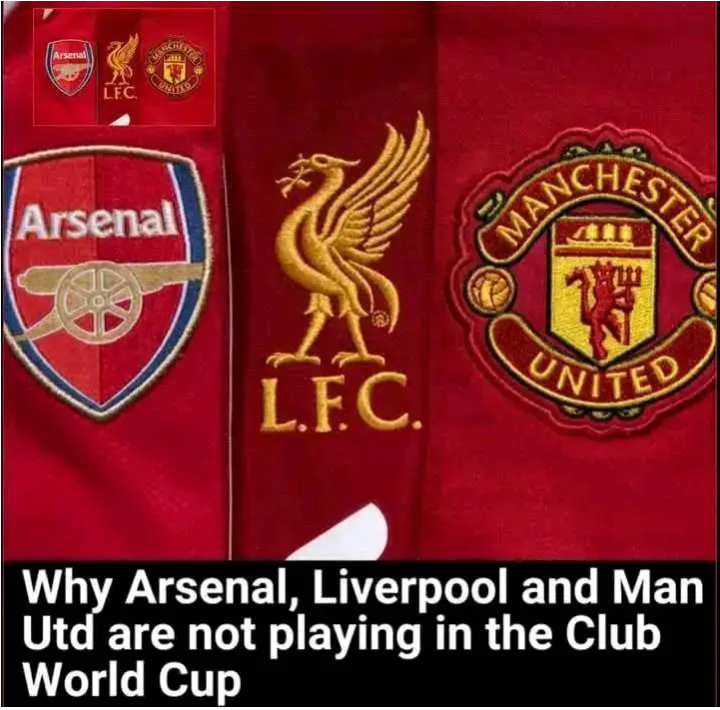The excitement surrounding the inaugural 32-team FIFA Club World Cup 2025, scheduled to take place in the United States from June 15 to July 13, is undeniable. It promises to be a groundbreaking global spectacle, a historic moment in club football. However, some of the biggest names in the sport will be conspicuously absent—namely, Arsenal, Liverpool, and Manchester United.
A Tournament of a New Era
The revamped Club World Cup will now be held every four years, much like the FIFA World Cup, and will feature 32 elite clubs from across the globe. UEFA will contribute 12 teams, with others representing South America, Asia, Africa, North America, and Oceania. But with greatness comes restrictions—and England’s traditional heavyweights have fallen victim to the tournament’s strict entry rules.
FIFA’s Qualification Criteria Explained
FIFA introduced clear but unforgiving qualification rules. Every country can send a maximum of two clubs, unless three or more teams from the same country win their confederation’s top club competition during the 2021–2024 qualification cycle.
In Europe, this refers specifically to the UEFA Champions League. Any club winning it during the four-year cycle earns automatic qualification.
Manchester City and Chelsea Take the Spots
For England, the two clubs that met the qualification criteria were Manchester City and Chelsea. City won the 2022/23 UEFA Champions League, while Chelsea triumphed in the 2020/21 edition. These victories guaranteed them a spot and filled England’s two allocated slots.
As a result, Liverpool and Manchester United, despite their rich European pedigree, were shut out.
Why Liverpool Missed Out
Liverpool had high hopes of qualification given their consistent performances in Europe, including a Champions League final appearance in 2022 and deep knockout stage runs in subsequent seasons. However, without a Champions League trophy in the qualifying window, and with City and Chelsea already having booked the English spots, their efforts weren’t enough.
Manchester United’s Case
Manchester United also found themselves locked out. While they participated in Champions League campaigns and reached the 2023 FA Cup final, they didn’t come close to lifting the continental title during the key qualification period. Their return to prominence under Erik ten Hag came too late to secure a berth.
Arsenal’s Slim Chance Falls Apart
For Arsenal, the situation was slightly different. The Gunners could have made it to the Club World Cup if they had won the 2023/24 Champions League. But after an encouraging campaign, they were eliminated in the quarter-finals by Bayern Munich, ending their hopes of joining the global showcase.
Two-Club Limit Sparks Frustration
The two-club-per-country rule has stirred debate. Critics argue that it penalizes high-performing teams from top leagues, while clubs from less competitive countries qualify due to less intense domestic competition. In England’s case, at least four clubs regularly compete at the highest European level, but only two are allowed entry.
Other European Giants Also Miss Out
This isn’t just an English problem. Clubs like Barcelona failed to qualify because Real Madrid and Atlético Madrid occupied Spain’s two spots. Similarly, teams like AC Milan, Napoli, and RB Leipzig, despite their strong domestic and European records, won’t feature in the tournament.
Champions League Wins = Golden Ticket
The structure of the tournament heavily favors Champions League winners. In fact, the fastest route to qualification is to win it outright. That’s how Real Madrid, Bayern Munich, and PSG sealed their spots. For other clubs, ranking points in UEFA competitions were considered—but only within FIFA’s capped limits.
UEFA’s 12-Team Representation
UEFA will send 12 clubs to the tournament, making it the most heavily represented confederation. The full list includes Real Madrid, Chelsea, Manchester City, Bayern Munich, PSG, Inter Milan, Juventus, and others who qualified either by winning the Champions League or via FIFA’s ranking system.
Tournament Structure and Format
The 32 clubs will be divided into eight groups of four, with the top two from each group advancing to a knockout stage. The final will take place in mid-July, providing fans with a World Cup-like summer experience—but for clubs, not nations.
United States: The Host Nation
The USA will host all matches, giving fans in North America a rare chance to witness Europe’s best clubs live on home soil. Stadiums across New York, Miami, Los Angeles, Atlanta, and Dallas are expected to serve as venues.
Financial and Commercial Impact
Missing out on this tournament means missing out on millions in revenue. Participating clubs will gain significant broadcasting, sponsorship, and ticket sales income, as well as global exposure. It’s a painful blow for Arsenal, Liverpool, and United, especially in a post-pandemic world where financial recovery is vital.
Strategic Wake-Up Call
For Arsenal, Liverpool, and Manchester United, this snub serves as a strategic wake-up call. Future participation will depend not just on strong league campaigns, but on European dominance. Domestic success alone is no longer enough.
Fans’ Disappointment and Reactions
The news has not gone down well with fans. Social media platforms were flooded with frustrated comments, with many pointing fingers at UEFA, FIFA, or even their clubs’ inability to win crucial matches in recent seasons. A sense of missed opportunity looms large among supporters.
Looking Ahead to 2029
The next edition of the Club World Cup will take place in 2029. That gives these clubs four more seasons to recalibrate, dominate Europe, and reclaim their place among the world’s best. The journey begins now.








